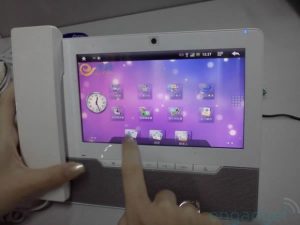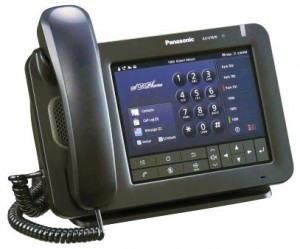Android gained huge popularity with smartphone manufacturers, so it should come as no surprise that the desk phones featuring Android operating platform would start appearing. Lots of companies have been rumored to be working on Android tablets this year in the wake of the iPad 3 launch. What we haven’t heard much of until now is an Android-based desktop handset. Some have recently begun working on Android-powered desk phones.
Why put Android on a desk ? For one: plenty of apps, including visual voicemail, calendars, SMS, and email. Android-based technology offers you the first phone that gets smarter over time instead of obsolete. The other reason is that Google has broad plans for Android. In May of 2011 as it was shipping its new 3.1 version of Android at the company’s annual developer’s conference, Google announced that the next release of its operating system will offer features that would make it more suitable for use on a a big-screen, multi-touch desktop computer. And this, my friends, could have far reaching consequences for Apple and even Microsoft.
Of the new desktop phones running Android – a few are worth mentioning:
A prototype design by Rockchip was seen at IFA 2010. The device – which features both: landline, SIP and 3G connectivity – can reportedly be used to make video calls or surf the web.
Another interesting solution designed by Cloud Telecomputer rocked an 8-inch full-color touchscreen, HD Audio, Bluetooth connectivity and desktop computer integration. That means such niceties as touch-to-dial, support for various VoIP clients and native noise cancellation and DSP, together with power-over-Ethernet and visual voicemail. It’s also capable of querying web directories such as LinkedIn during calls, so you can check up on a contact’s credentials while you’re chatting with them. Cloud Telecomputers also expects lots of third party Android apps to be built especially for the business phone platform.

In the summer of 2010 Cisco became the first big player to officially announce an enterprise Android tablet. The product is called the Cisco Cius (as in “see us”) and it offers a much different take on the tablet than either the iPad or the Tablet PCs that we saw from Microsoft and its hardware partners in the past decade. Cisco has very little experience or expertise building consumer electronics or computing devices, so this is uncharted territory. And, judging by the design of Cius, it shows. As you can see in the photo below of the Cius in its desk phone docking station, Cisco has built the product to be a companion to its enterprise VoIP, video, and collaboration services describing it as “a lightweight portable business computing tablet offered with an optional HD audio station equipped with a telephone handset speakerphone, HD Display Port and USB ports. And while this device is primarily designed to support Cisco’s proprietary collaboration technologies, Android operating platform offers a broad variety of open SIP/Video phone applications. There’s one aspect of the Cius that could make it very appealing in the enterprise. The always-on connectivity of 3G (and eventually 4G) mobile data services combined with Cisco’s built-in VPN software and a virtual desktop infrastructure could provide highly mobile (desk-less) workers with an instant-on device that has secure connectivity to all of their corporate apps and data from virtually anywhere.
A call from a Panasonic product rep came as Steve and I were discussing a choice of new SIP desktop phones we would be adding to the up and coming 3.3 release of DLS Hosted PBX software. I agreed to meet with him to preview the new generation KX-UT670 Android-based SIP desktop handset. The new UT series are Panasonic’s latest attempt to enter Hosted PBX endpoint device market and from both engineering and user prospective it felt like love from the first sight.
Simple and intuitive “plug and play” service provisioning makes the phone easily configurable automatically. All terminals support Power over Ethernet technology. Smart Desktop Models UT670 and UT248 offer touch screen and Executive Desk with integrated Bluetooth. They are true data processing centers as much as they are SIP Phones, however, they are prepared to work just as well in the home as in business environments. Panasonic has prepared the launch of more than about ten SIP Phones all with their own design, unique technology and environmentally friendly ethos. Likewise, it brings to the forefront their new audio systems that produce high definition signals for all of their new range of telephones, which permits the conversations be clearer than those found in previous calls.
The Panasonic KX-UT series has six terminals; the Panasonic KX-UT113, Panasonic KX-UT123, Panasonic KX-UT133 and Panasonic KX-UT136 come as desktop solutions that cover the range from standard up to professional office. On the whole, the Panasonic KX-UT248 and Panasonic KX-UT670 will be responsible for the executive level and office work respectively. Both work with Android and are capable of integrating with business applications.
7 inch, 262k color, LCD touch screen display with intuitive User Interface offer fast access to phonebooks and features offering the user a much enhanced experience. A built in Electronic Hook Switch (Plantronics compliant) port allows the KX-UT133 and KX-UT136 SIP Terminals to have access to the Plantronics range of DECT enabled headsets. This offers a range of portability and comfort as frequent users are able to move around freely, without being tied down by handsets.
Some things are clear: Android platform and tablets are becoming the next wave of unified communications devices. In the bigger picture this means that tablets are being accepted as valuable elements of business communications and collaboration. Market for these devices is about to become wildly competitive and the possibilities offerred by free application marketplace are endless.


